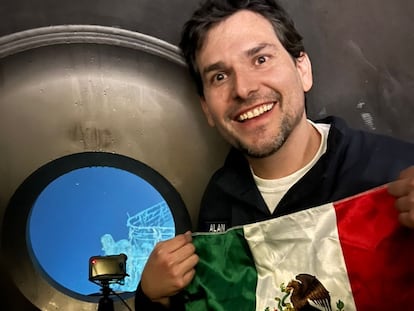Mexican youtuber who traveled on ‘Titan’ last year: ‘I was aware that I was risking my life’
In 2022 Alan Estrada traveled aboard the OceanGate submersible, now missing with five people on board. He signed documents accepting all the risks

The youtuber Alan Estrada had to organize a press conference on Thursday to answer questions about various videos he made two years ago. The actor was the first Mexican citizen to travel aboard the OceanGate submersible Titan, now lost in the North Atlantic with five people aboard. Estrada has a YouTube channel, called Alan around the world, and a travel blog. In July 2021, he tried to embark on the expedition to visit the wreck of the Titanic, submerged at a depth of 3,800 meters (12,467 feet), 600 kilometers (372 miles) south of Canada. However, the Titan’s systems failed, and the trip had to be cancelled. He tried again a year later, and this time he was successful. He now confirms that it was “a spectacular trip” although he would not repeat it: “I was aware that I was risking my life. I knew what could happen.”
Estrada, 42, began receiving dozens of calls on Monday as soon as the news broke: contact had been lost with a private submarine on its way to visit the wreck of the famous ocean liner, which sank in 1912. The search was urgent, as the submersible had an oxygen reserve of only 96 hours. Two days later, Estrada recounted the details of the expedition in which he participated.
To begin, he acknowledged, it’s “very expensive.” He sought sponsors to pay the $150,000 required for the trip. Now, it costs even more: $250,000 (about €230,000). “As the expeditions have been successful, they’ve increased the price, because in the beginning it was basically ‘let’s see if this happens,’” the youtuber explained.” It’s overpriced, but I recognize the investment it takes to create a submersible like that and be out at sea for weeks,” he said.
Before boarding the Titan, the first carbon-fiber submersible capable of reaching a depth of 4,000 meters, you have to sign several documents, “which explain exactly what risks” you are running, “including losing your life, of course.” “We knew that this was an incredibly risky expedition, we knew that we were not going to an amusement park,” said Estrada, who at several points in the news conference insisted that those who board the Titan are adults aware of what kind of adventure they are embarking on. “For example, one of the clauses is not to suffer from claustrophobia.”
Once inside the submersible, if all goes well, it takes about two hours to descend to 3,800 meters, four hours to tour the wreck of the Titanic and the bottom of the ocean, and another two hours to ascend to the surface. This was the case with Estrada’s expedition: “It was one of the more successful ones. The one before ours, on the other hand, lasted 27 hours because they had had problems recovering the submersible.”
Inside, the Titan is like an empty tube, 6.5 meters long and 2.8 meters wide, in which there are no seats and no standing room. There is also no bathroom per se, but there is a curtained-off cubicle. The Titan is intended to make a short voyage, although Estrada believes it has what it takes to keep the crew alive for 96 hours if “the submersible is intact.”
Five people can fit inside. These are usually the pilot and co-pilot, and three civilians, who are called “mission specialists.” Estrada completed his expedition with one of the men who is now missing, the French explorer Paul Henri Nargeolet: “He was the co-pilot, but when we arrived at the ship, he was the one piloting the submersible because he knows the wreck extremely well. He has been down to the wreck of the Titanic almost 40 times, and is one of the most trusted people to go down. But if you ask his opinion, he says there is always a risk and there are always complications. On some of his dives — he also went down in French submersibles — the crew even had to put out internal fires.”
Estrada is also well acquainted with OceanGate CEO Stockton Rush, another of the missing crew members. “Stockton is a very positive person. He designed the Titan; it’s his dream, his mission. I hope they are all inside, waiting to be rescued,” he said. The other three people inside the submersible are British businessman Hamish Harding, an adventurer who holds three Guinness World Records, and Shahzada Dawood, a Pakistani-born British businessman, and his son Suleman.
On Monday, communication with the Titan was lost when it was only one hour and 45 minutes into the expedition. According to Estrada’s calculations, it was still going down. For the first few meters, communication is by radio, then, when the signal is lost, via messages. It is part of the protocol that if communication is not re-established in one hour, the submersible must return to the surface. Based on that information, the youtuber believes there is a possibility that the submarine ascended and is now in the ocean waiting to be rescued. Another fundamental complication is that the Titan cannot be opened from the inside, only from the outside.
In the worst-case scenario, Estrada noted, the submersible has got tangled in something: “If it gets stuck it has no systems. It can’t grab objects; it doesn’t have that technology. It would take another submersible to find them.” All this, he said, is something the crew members know: “We knew it was an experimental submersible.” For example, on his first expedition attempt in 2021, the trip had to be cancelled because the ballast system — the mechanism the submarine uses to descend and ascend — got stuck. “Titan could go down, but it could no longer go up because the ballast casting system got stuck. There was an emergency system where the submersible could jettison the whole mechanism, not just the ballast, so Titan would come back up, and that’s what happened.”
OceanGate offered Estrada an expedition on July 2, 2022 as compensation. “The following year the company had changed the ballast system, they were no longer tubes, but kind of sacks with weights. It also has other emergency mechanisms, such as an air bag that is activated internally and inflated externally, so that Titan becomes buoyant and can rise to the surface,” he said. “To me the safety protocols seemed serious. It was like a rocket launch. Before each of the submersible’s maneuvers, whether it was on the launch pad, in the water, and before we submerged, all the equipment was stopped, and all the systems were checked.”
Sign up for our weekly newsletter to get more English-language news coverage from EL PAÍS USA Edition
Tu suscripción se está usando en otro dispositivo
¿Quieres añadir otro usuario a tu suscripción?
Si continúas leyendo en este dispositivo, no se podrá leer en el otro.
FlechaTu suscripción se está usando en otro dispositivo y solo puedes acceder a EL PAÍS desde un dispositivo a la vez.
Si quieres compartir tu cuenta, cambia tu suscripción a la modalidad Premium, así podrás añadir otro usuario. Cada uno accederá con su propia cuenta de email, lo que os permitirá personalizar vuestra experiencia en EL PAÍS.
¿Tienes una suscripción de empresa? Accede aquí para contratar más cuentas.
En el caso de no saber quién está usando tu cuenta, te recomendamos cambiar tu contraseña aquí.
Si decides continuar compartiendo tu cuenta, este mensaje se mostrará en tu dispositivo y en el de la otra persona que está usando tu cuenta de forma indefinida, afectando a tu experiencia de lectura. Puedes consultar aquí los términos y condiciones de la suscripción digital.
More information
Archived In
Últimas noticias
Most viewed
- David King, chemist: ‘There are scientists studying how to cool the planet; nobody should stop these experiments from happening’
- Reinhard Genzel, Nobel laureate in physics: ‘One-minute videos will never give you the truth’
- Mexico completes its trade shift with the entry into force of tariffs on China and countries without trade agreements
- Oona Chaplin: ‘I told James Cameron that I was living in a treehouse and starting a permaculture project with a friend’
- Sinaloa Cartel war is taking its toll on Los Chapitos











































